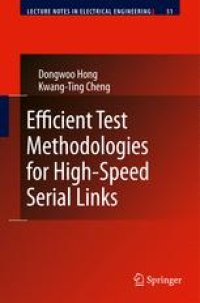
Ebook: Efficient Test Methodologies for High-Speed Serial Links
- Tags: Circuits and Systems, Register-Transfer-Level Implementation
- Series: Lecture Notes in Electrical Engineering 51
- Year: 2010
- Publisher: Springer Netherlands
- Edition: 1
- Language: English
- pdf
With the increasing demand for higher data bandwidth, communication systems’ data rates have reached the multi-gigahertz range and even beyond. Advances in semiconductor technologies have accelerated the adoption of high-speed serial interfaces, such as PCI-Express, Serial-ATA, and XAUI, in order to mitigate the high pin-count and the data-channel skewing problems. However, with the increasing number of I/O pins and greater data rates, significant challenges arise for testing high-speed interfaces in terms of test cost and quality, especially in high volume manufacturing (HVM) environments. Efficient Test Methodologies for High-Speed Serial Links describes in detail several new and promising techniques for cost-effectively testing high-speed interfaces with a high test coverage. One primary focus of Efficient Test Methodologies for High-Speed Serial Links is on efficient testing methods for jitter and bit-error-rate (BER), which are widely used for quantifying the quality of a communication system. Various analysis as well as experimental results are presented to demonstrate the validity of the presented techniques.
With the increasing demand for higher data bandwidth, communication systems’ data rates have reached the multi-gigahertz range and even beyond. Advances in semiconductor technologies have accelerated the adoption of high-speed serial interfaces, such as PCI-Express, Serial-ATA, and XAUI, in order to mitigate the high pin-count and the data-channel skewing problems. However, with the increasing number of I/O pins and greater data rates, significant challenges arise for testing high-speed interfaces in terms of test cost and quality, especially in high volume manufacturing (HVM) environments. Efficient Test Methodologies for High-Speed Serial Links describes in detail several new and promising techniques for cost-effectively testing high-speed interfaces with a high test coverage. One primary focus of Efficient Test Methodologies for High-Speed Serial Links is on efficient testing methods for jitter and bit-error-rate (BER), which are widely used for quantifying the quality of a communication system. Various analysis as well as experimental results are presented to demonstrate the validity of the presented techniques.
With the increasing demand for higher data bandwidth, communication systems’ data rates have reached the multi-gigahertz range and even beyond. Advances in semiconductor technologies have accelerated the adoption of high-speed serial interfaces, such as PCI-Express, Serial-ATA, and XAUI, in order to mitigate the high pin-count and the data-channel skewing problems. However, with the increasing number of I/O pins and greater data rates, significant challenges arise for testing high-speed interfaces in terms of test cost and quality, especially in high volume manufacturing (HVM) environments. Efficient Test Methodologies for High-Speed Serial Links describes in detail several new and promising techniques for cost-effectively testing high-speed interfaces with a high test coverage. One primary focus of Efficient Test Methodologies for High-Speed Serial Links is on efficient testing methods for jitter and bit-error-rate (BER), which are widely used for quantifying the quality of a communication system. Various analysis as well as experimental results are presented to demonstrate the validity of the presented techniques.
Content:
Front Matter....Pages i-xi
Introduction....Pages 1-5
An Efficient Jitter Measurement Technique....Pages 7-18
BER Estimation for Linear Clock and Data Recovery Circuit....Pages 19-40
BER Estimation for Non-linear Clock and Data Recovery Circuit....Pages 41-51
Gaps in Timing Margining Test....Pages 53-64
An Accurate Jitter Estimation Technique....Pages 65-73
A Two-Tone Test Method for Continuous-Time Adaptive Equalizers....Pages 75-87
Conclusions....Pages 89-90
Back Matter....Pages 91-98
With the increasing demand for higher data bandwidth, communication systems’ data rates have reached the multi-gigahertz range and even beyond. Advances in semiconductor technologies have accelerated the adoption of high-speed serial interfaces, such as PCI-Express, Serial-ATA, and XAUI, in order to mitigate the high pin-count and the data-channel skewing problems. However, with the increasing number of I/O pins and greater data rates, significant challenges arise for testing high-speed interfaces in terms of test cost and quality, especially in high volume manufacturing (HVM) environments. Efficient Test Methodologies for High-Speed Serial Links describes in detail several new and promising techniques for cost-effectively testing high-speed interfaces with a high test coverage. One primary focus of Efficient Test Methodologies for High-Speed Serial Links is on efficient testing methods for jitter and bit-error-rate (BER), which are widely used for quantifying the quality of a communication system. Various analysis as well as experimental results are presented to demonstrate the validity of the presented techniques.
Content:
Front Matter....Pages i-xi
Introduction....Pages 1-5
An Efficient Jitter Measurement Technique....Pages 7-18
BER Estimation for Linear Clock and Data Recovery Circuit....Pages 19-40
BER Estimation for Non-linear Clock and Data Recovery Circuit....Pages 41-51
Gaps in Timing Margining Test....Pages 53-64
An Accurate Jitter Estimation Technique....Pages 65-73
A Two-Tone Test Method for Continuous-Time Adaptive Equalizers....Pages 75-87
Conclusions....Pages 89-90
Back Matter....Pages 91-98
....